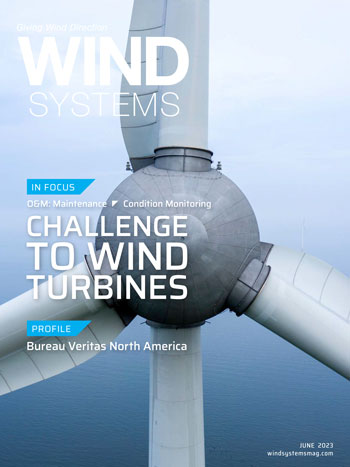Who is Electrom, and what do you do for wind energy?
Electrom has been a developer and manufacturer of electronic test equipment for the motor industry and generator industry for 37 years now. The instruments are used to test the insulation systems in any rotating machinery, as well as other types of coils like antennas. In the wind industry, one of the most important components is the generator.
The instruments are used for diagnosis of problems with the generators, as well as for maintenance programs. In a nacelle, there are also other motors that are often tested, and that would be yaw motors and pitch motors if they are electric. When something goes wrong with a wind-turbine system, they don’t necessarily know what’s impacted by it or exactly what it is that has failed. It can be all kinds of mechanical things, but it also can be all kinds of electrical things.
Testing the generator to make sure there’s nothing wrong with it is pretty key. That can be done very quickly and efficiently. The objective for us as a company is to help the wind-power operators find their problems quickly, reduce maintenance or operating costs, and frankly, keep them running.
Sometimes owner-operators may plan to remove a generator for repair and reconditioning, and, it turns out through testing in the nacelle that there isn’t anything wrong with it. There’s something ancillary to that, and that’s a gigantic savings. It’s expensive to remove the generator and put in a new one, so the opportunity for savings with having proper testing is very big.
How long have you been working with wind?
We probably sold the first testers to wind people at least 10 years ago. And when we say wind people — meaning people in the wind-power industry — it’s a range. It is service companies; it’s what we call motor shops. Some of the motor shops are servicing the wind industry and then, of course, the O&M — the operators and owners. So, it’s hard to say exactly when it started because we’ve been dealing with these motor shops and service companies for a long time. But, we started selling to wind farms probably about 10 years ago. And in the last three years, it’s really accelerated. We are focused on it because the potential benefit to the operators is very big. Some of the biggest wind service companies that help out the operators are big customers of ours.
Recently, we’ve gotten some significant orders from wind operators — the people who operate wind farms. It’s a big focus for our company. We have people who can help them in the field who are climbing certified. We’re just now releasing a new series of testers that are significantly smaller than what we had before. Operators appreciate that, of course, having to bring this up in the tower. We also offer service capability in terms of training and helping people actually on-site up in the tower.
Who uses Electrom motors and generator testers?
There are three broad markets. One is the motor shops and the service companies. The other one is motor and coil manufacturers. Somebody makes these generators and electric motors, and they need this equipment to detect anything that goes wrong in production and for diagnosing problems. And the other big market are industrial end users — people who are large users of motors and generators. You can say the wind market falls into that category, but, frankly, we look at the wind industry as a separate market.
What is iTIG and what makes it ideal for wind energy?
The iTIG is a motor tester or generator tester. They’re referred to as that. But they’re also referred to as winding analyzers because there are electrical windings in generators and electric motors. The objective is to be able to diagnose the condition of those windings to find out if everything is fine, if they are very dirty, if they need to be reconditioned, or if they have a weakness or if they are busted. The tester can find and diagnose all of those things. It has a range of low voltage measurements and tests. They measure the resistance in the windings, the inductance in the windings, the capacitance, and so forth.
They can do what is called a Meg test, which is very common. Most people in the maintenance industry will know what the Meg test is, an insulation resistance test. But the things that help you find weaknesses in the insulation are high voltage tests, because you have to stress the insulation in order to find out whether it has proper integrity or whether there is a weakness present. You stress the insulation by using a DC Hipot test. Hipot is essentially just a Meg test that’s done at a much higher voltage. It can find out whether you have ground insulation issues. The most important test is what is called a surge test, which is putting fast rising voltage pulses into the windings, which helps you find weaknesses turn-to-turn in the windings, from one winding turn to the next, or a few down.
The reason why that is so important is that the industry guideline for the motor shop industry, as well as for industrial users who do maintenance programs, says something like 80 percent of the winding failures start with a turn-to-turn insulation weakness, then ends up becoming a fault. Once it becomes a fault, you’re going to have excessive heat created where this happens, and it’s going to get worse and worse, and eventually fail the ground wall and then you’re busted.
If you can find out if you have a weakness in there, then you can usually prevent a problem from happening or you can schedule a replacement. In some cases, there are weaknesses in wind generators that can be fixed on-site up in the nacelle — especially with exit leads and wiring, and Y-rings in the rotor. There are a number of things that can be fixed before it becomes a really big problem right in a nacelle. And if not, then at least you can schedule to have the generator replaced and keep producing electricity in the meantime. That’s what the instrument is used for. It has 20 different tests that you can make in one portable instrument that you can bring up in the nacelle.
What are the benefits of high voltage testing of these generators?
The benefit is that you can find the weaknesses, which you cannot find without stressing the insulation. A high voltage test is designed to stress the insulation in the windings, both the ground wall and the turn-to-turn insulation. That’s the benefit.
The objective often is to try to find those weaknesses before you have a catastrophic failure. But if the turbine has stopped, and you want to do a quick check to see if it is or isn’t the generator, then you do one of these tests and you will immediately know whether this one is busted or if it has a weakness, that may cause trouble to get it started, for example.
Can you test other motors in use in a wind turbine?
You can test any type of winding, so that would include yaw motors and pitch motors, and sometimes there are other types of equipment in a tower that can be tested as well. But those would be the two main ones.
How does your company make high voltage testing more approachable for end users?
We provide training and support, which is critical to get people to become experts in this field. That training can be online and tailored to that particular customer and their knowledge. But we do both onsite and online training, and everything we do online or by phone and email, etc., is free, which people appreciate because they can get some refreshers, or they may run into some situation they have not seen before. When that happens, they can contact us. We do a TEAMS meeting or Zoom meeting or short phone training session on the subject at hand. Customer service is one of our strategic objectives to have that customer service be the best in the industry. And customers tell us we are there now, but it’s something you always have to work on.
We have two main strategic objectives. One is to be the technology leader, and that’s something that can always be argued as to who is the technology leader. But many of our customers have recently said that we have been the innovator, and that we have testers that are easier to use and more robust than others. The other part is the customer-service side, because without excellence in customer service, you are not going to necessarily have a customer for long.
When you are up in a tower and you have a problem or you see something you haven’t seen before, time is of the essence. So, having good support that you can count on is critical, and that is one of the value propositions that we offer.
More info www.electrominst.com































